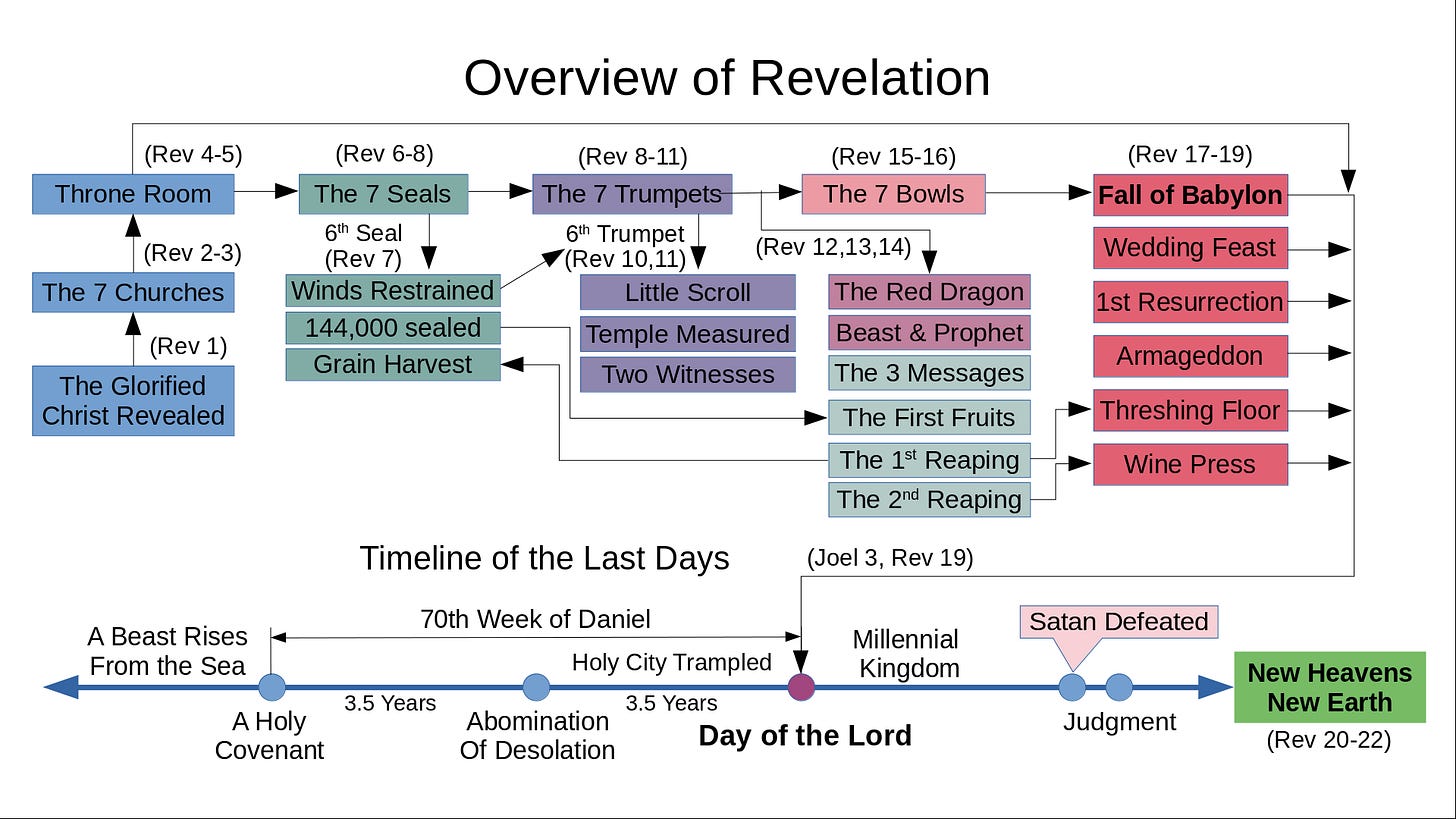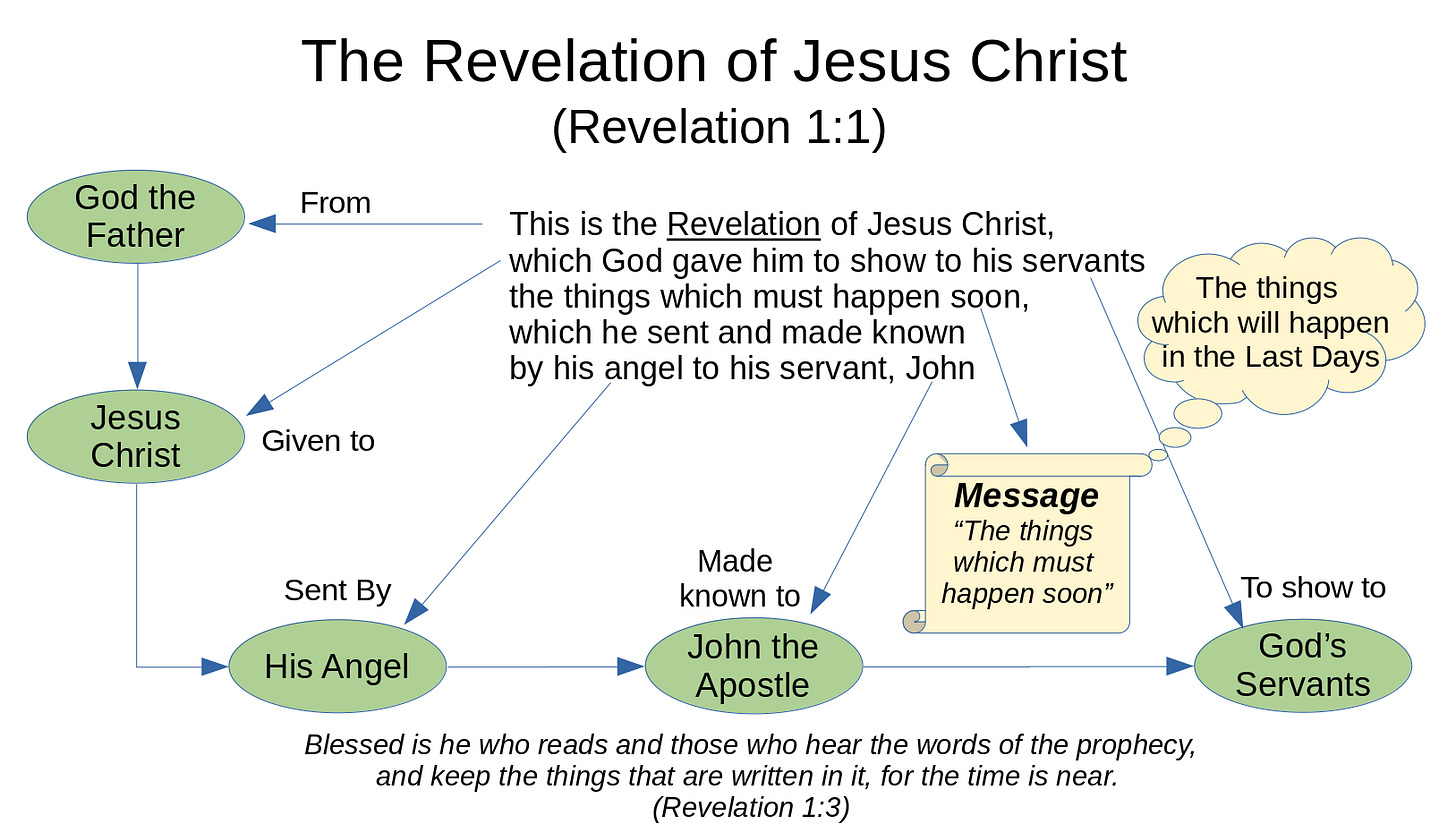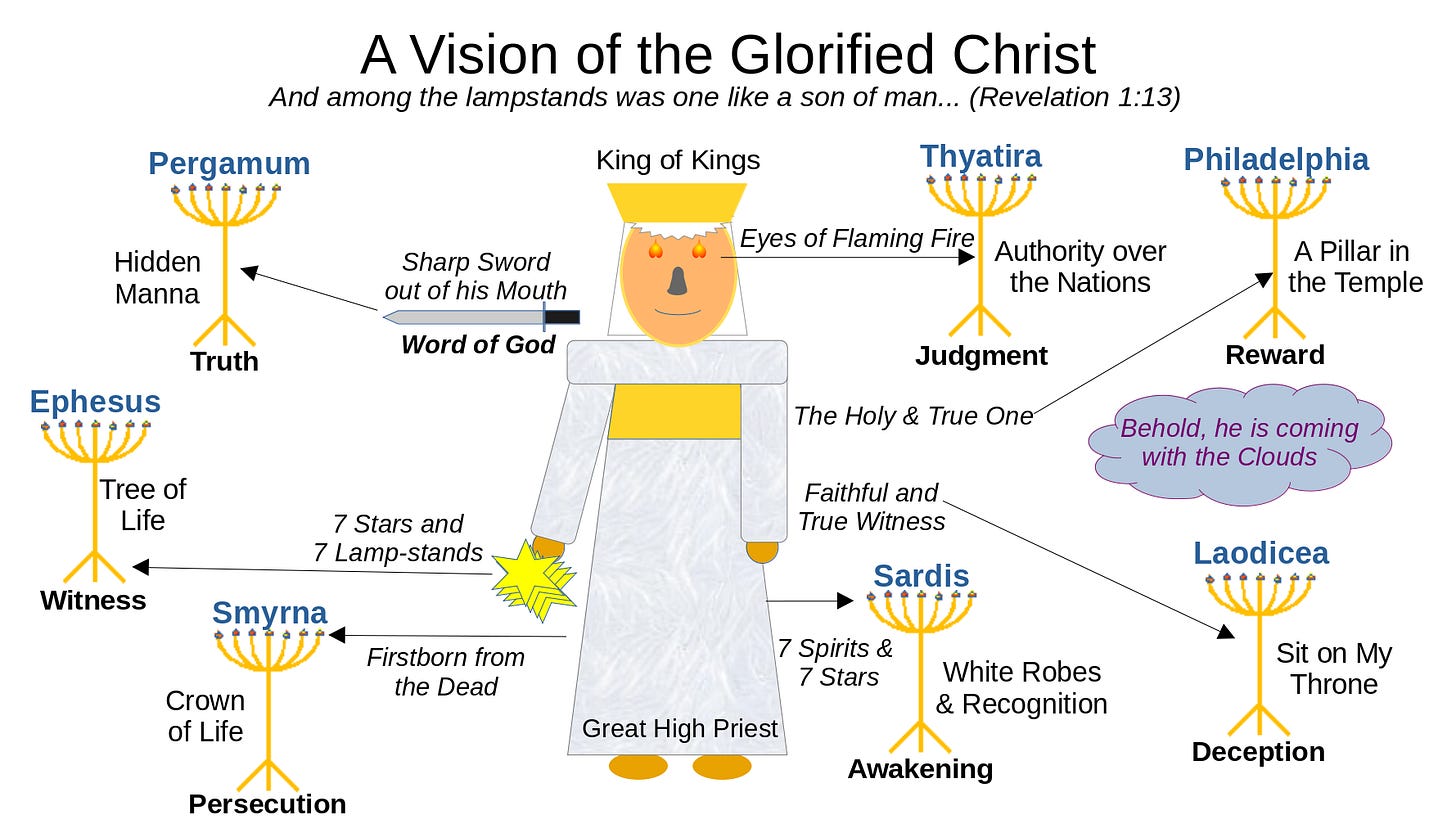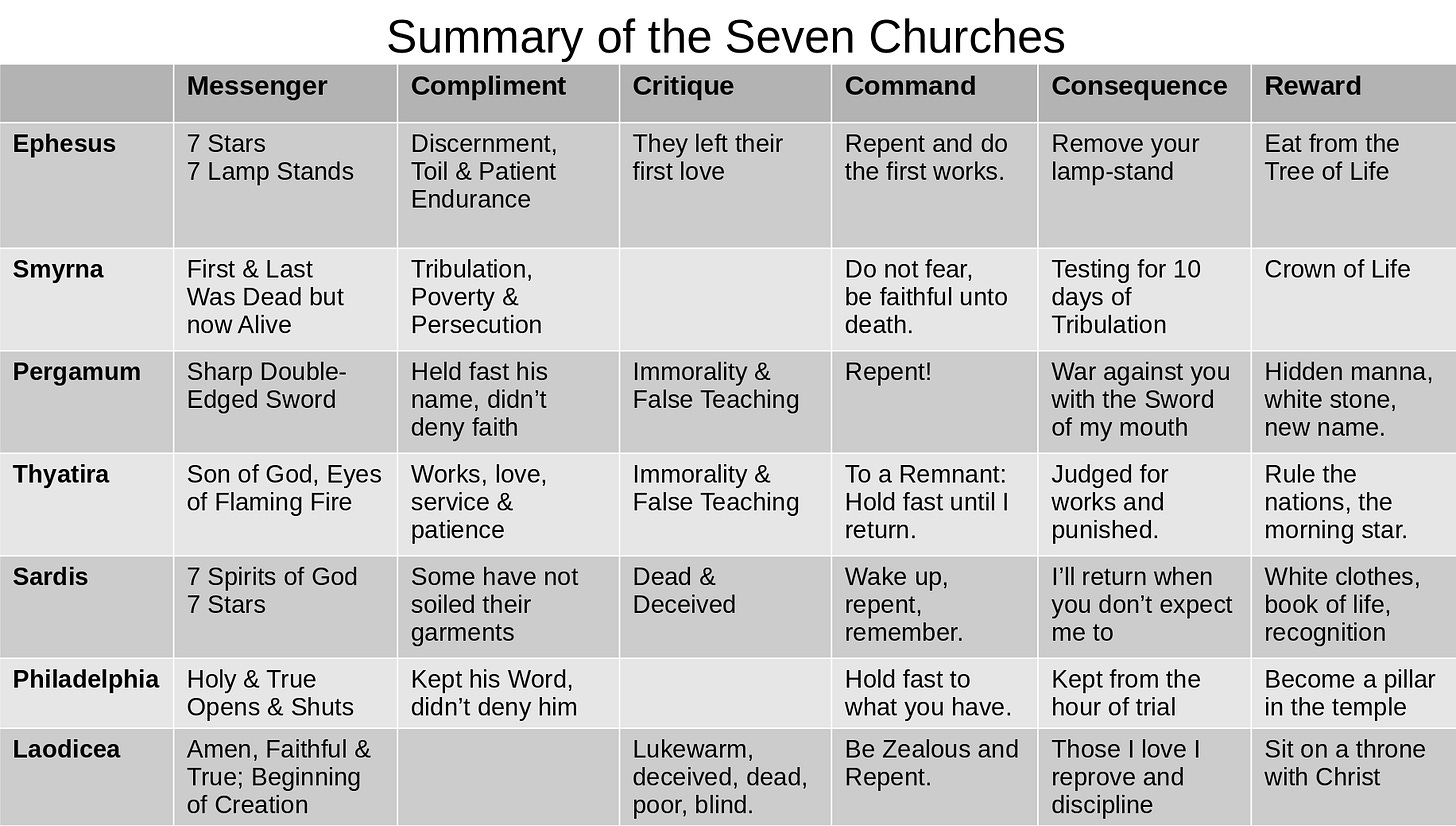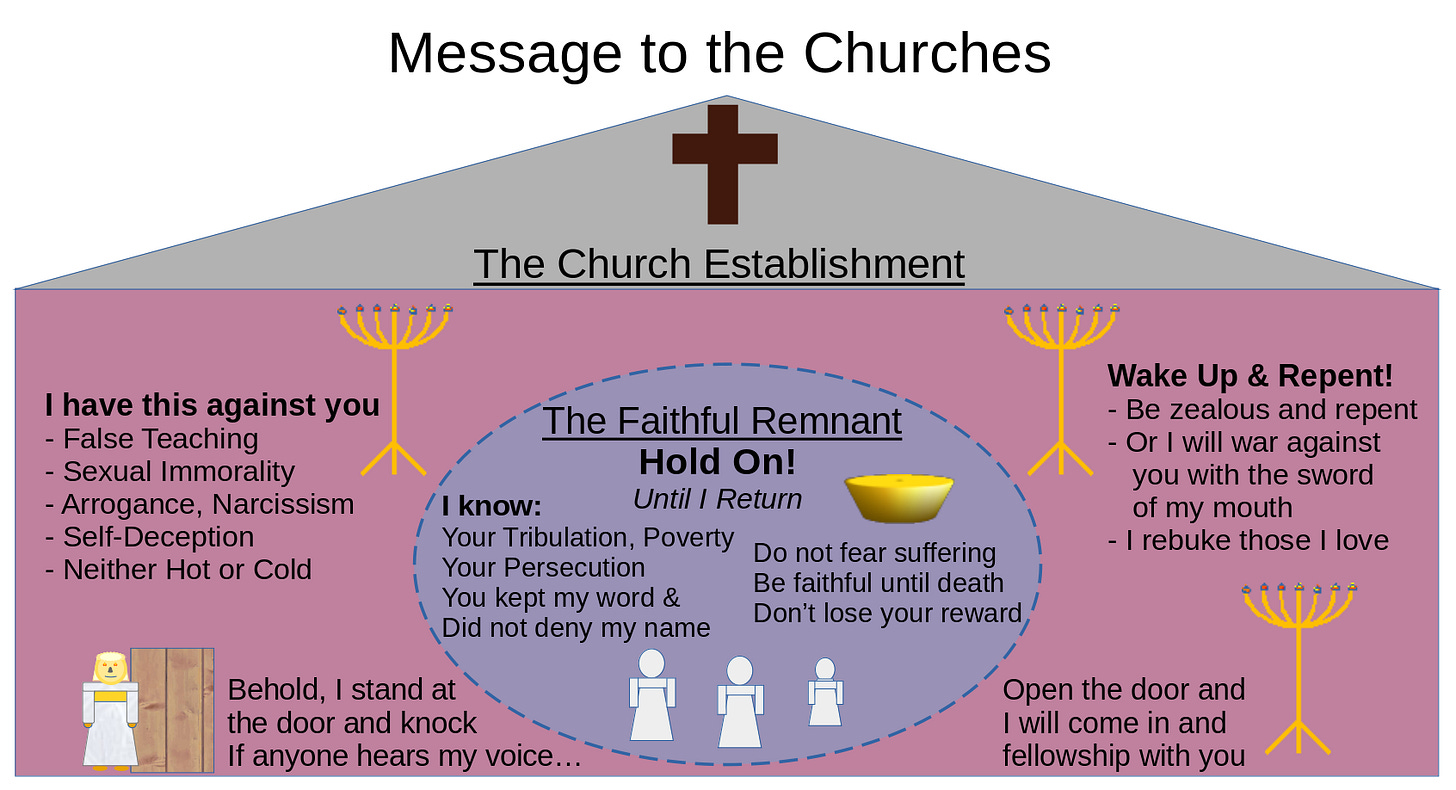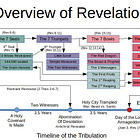A Warning to the Churches
The Son of Man and the Seven Churches - Revelation Chapters 1-3
"Behold, I come quickly. Blessed is he who keeps the words of the prophecy of this book." (Revelation 22:7)*
The book of Revelation is a complicated text to read. It is a form of writing called “apocalyptic literature” and it contains a lot of symbolism and poetry. The main narrative follows a series of sevens. Seven churches, seven seals, seven trumpets, and seven bowls. Inserted into the main themes are details which are rich with symbolism. The following illustration has been created as a road-map to guide you through the book.
Blessing and Introduction
Welcome to the Revelation of Jesus Christ. This book opens with a declaration that it is a message from the Father, given to Jesus, so that he might show his servants the things which will soon happen. He delivered this message to his servant John by way of an angel.
[1] This is the Revelation of Jesus Christ, which God gave him to show to his servants the things which must happen soon, which he sent and made known by his angel to his servant, John, [2] who testified to God's word, and of the testimony of Jesus Christ, about everything that he saw. [3] Blessed is he who reads and those who hear the words of the prophecy, and keep the things that are written in it, for the time is near.
(Revelation 1:1-3)*1
There is a blessing for those who read, and hear, and keep the things written in this prophesy. Many people that I have talked to are missing out on this blessing because they think this book will be dark and depressing, so they avoid it. The dragon, who deceives the entire world, has distorted public perception of end-times and the Apocalypse in order to discourage people from reading it, understanding it, and receiving the blessing.
Why did God reveal this message to His servants? Surely, it was not so they would become fearful and without hope. This prophecy contains a powerful message of hope for the servants of God who are chosen to be holy, righteous, kings and priests in a kingdom that will never end.
[4] John, to the seven churches that are in Asia: Grace to you and peace, from him who is and who was and who is to come; and from the seven Spirits who are before his throne; [5] and from Jesus Christ, the faithful witness, the firstborn of the dead, and the ruler of the kings of the earth. To him who loves us, and washed us from our sins by his blood; [6] and he made us to be a Kingdom, priests to his God and Father; to him be the glory and the dominion forever and ever. Amen. (Revelation 1:4-6)*
John offers greetings to the seven churches in Asia minor (in the region of modern-day Turkey). He explains that he is writing from the island of Patmos where he was imprisoned for the testimony of Jesus Christ. On the Lord’s day he was in the Spirit when he heard a loud voice telling him to write what he saw in a scroll and send it to these seven churches.
[9] I John, your brother and partner with you in persecution, Kingdom, and patient endurance in Jesus, was on the island that is called Patmos because of the word of God and the testimony of Jesus. [10] I was in the Spirit on the Lord's day, and I heard behind me a loud voice, like a trumpet [11] saying, "What you see, write in a scroll and send to the seven churches: to Ephesus, Smyrna, Pergamum, Thyatira, Sardis, Philadelphia, and to Laodicea." (Revelation 1:9-11)*
John describes himself as a brother and partner in persecution, Kingdom, and patient endurance. This is how he viewed his life of service for Jesus Christ. It is a path of persecution and patient endurance for those waiting for God’s Kingdom to come on the earth.
Symbolic References
When John turns around he sees a vision of the glorified Christ speaking with him. Nearly every phrase in this chapter is filled with symbolic meaning. This symbolism is used elsewhere in scripture to connect different visions and concepts with Jesus Christ. For example, Daniel chapter 7 says that “one like the son of man” is seen coming on the clouds of heaven. The same imagery shows up in this chapter and again when Jesus instructs the disciples about his return at the end of the age.
I saw in the night visions, and behold, there came with the clouds of the sky one like a son of man, and he came even to the Ancient of Days, and they brought him near before him. (Daniel 7:13)*
and then the sign of the Son of Man will appear in the sky. Then all the tribes of the earth will mourn, and they will see the Son of Man coming on the clouds of the sky with power and great glory. (Matthew 24:30)*
Behold, he is coming with the clouds, and every eye will see him, including those who pierced him. All the tribes of the earth will mourn over him. Even so, Amen. (Revelation 1:7)*
Jesus is described as “the faithful witness, the firstborn of the dead, and the ruler of the kings of the earth” in verse 5. His faithful witness is in contrast to the dishonest serpent who deceives the nations. As “ruler of the kings” he is the one who will take dominion over the earth and rule the nations with a rod of iron and with integrity.
John describes Jesus as the one “who loves us and washes us from our sins by his blood” and that “he made us to be a Kingdom, priests to his God and Father”. This image and concept is repeated often in Revelation as God’s faithful people are represented wearing clean, white garments and as kings and priests. They are cleansed and made righteous by the blood of the Lamb and given responsibility as rulers and mediators to facilitate God’s blessing of mankind on the earth.
John sees “one like the son of man” standing among seven golden lampstands wearing a long robe and a golden sash around his chest. In his hand are seven stars. The lampstands represent the churches because they are to be the light of the world to the nations. The stars are the angels (or messengers) for each of the churches and he has a message to deliver to each one. The sash represents his role as priest and just as he is king of kings, he is also the high priest over all the priests in the kingdom. He sits at the right hand of the Father to intercede for us all.
Jesus is described as having eyes like a flame of fire and a sharp two-edged sword proceeding out of his mouth. This is because he is the Word of God that is sharper than a two-edged sword and his piercing eyes can discern the thoughts and intent of our hearts. With this sword of truth he will defeat his enemies and overcome the kings of the nations in the Day of the Lord. Because their power and authority comes from the great dragon who is the devil and Satan, their empires are built upon lies and deception. The truth will ultimately overcome them and these kingdoms will collapse under the weight of their own corruption.
[12] I turned to see the voice that spoke with me. Having turned, I saw seven golden lampstands. [13] And among the lampstands was one like a son of man, clothed with a robe reaching down to his feet, and with a golden sash around his chest. [14] His head and his hair were white as white wool, like snow. His eyes were like a flame of fire. [15] His feet were like burnished brass, as if it had been refined in a furnace. His voice was like the voice of many waters. [16] He had seven stars in his right hand. Out of his mouth proceeded a sharp two-edged sword. His face was like the sun shining at its brightest.
(Revelation 1:12-16)*
There are many other symbols in this text that will point back to Jesus as they are revealed in other parts of the bible. His feet like burnished brass, his hair as white as wool, a loud voice like a trumpet, and the firstborn of the dead. Watch for these images as this symbolism shows up in other verses, it will point back to Jesus Christ being the subject of the vision or prophecy and in some cases it will clarify what the symbol represents.
[17] When I saw him, I fell at his feet like a dead man. He laid his right hand on me, saying, "Do not be afraid. I am the first and the last, [18] and the Living one. I was dead, and behold, I am alive forevermore. I have the keys of Death and of hell.
(Revelation 1:17-18)*
When John saw Jesus, he was terrified and fell at his feet as if he were dead. Jesus told him not to be afraid because He is the living one who has conquered death and is alive forevermore. This becomes an important point for God’s people in the tribulation. They do not need to fear, because Jesus has conquered the grave. This is why the saints overcome the dragon and defeat their enemies.
Letters to the Seven Churches
Remember therefore from where you have fallen, and repent and do the first works; or else I am coming to you, and will move your lampstand out of its place, unless you repent. (Revelation 2:5)
The next two chapters in Revelation contain the letters that John sent to the seven churches. This section will provide a high level overview of the messages rather than go through each letter line by line.
The letters are organized in the same way using a common template. They all begin with a greeting and introduction by the glorified Christ using some element of the symbolism that describes his appearance in chapter one. The symbolism in each letter corresponds to a key theme in the message for each church. Following the greeting, there is normally a statement of affirmation, followed by a correction, then a command, and sometimes a consequence that will follow if they do not obey the command. The letters end with a promise of reward to those who overcome. Generally, the symbolism in the promise will correspond with the symbols used in the greeting. The letters all close with an appeal, for those who have ears to hear, that they listen to what the Spirit says to the churches. The following table captures a high-level summary of these messages for each of the churches.
It is obvious from the table that one of the churches is not complimented for anything, and that two of the churches have no rebuke. Most of the churches are told to repent and change their ways, but others are told simply to hold tightly to what they have until the Lord returns. There are no perfect churches here, this assessment appears to be unbiased and accurate as it reflects the diversity of experiences one would find in churches even today. The other obvious pattern is that those who are the most faithful seem to experience the greatest persecution and suffering.
The interpretation of these letters is a multi-dimensional problem and it can be complex. One may interpret these churches as literal first century churches because they are. History and archaeology tell us that the characteristics of these cities, and their churches, align closely to the descriptions in these letters. Some have proposed that they represent a chronological history of the global church as the body of Christ. The final stage of the church, represented by Laodicea, is the most corrupted and apostate having drifted away from God to become lukewarm, blind, conceited and self-sufficient.
Another perspective is that these letters represent the state of different churches in the end-times. Various denominations can fit into these seven categories such that each letter is represented by a church somewhere in the world today. Given the overall context, placement and flow of the narrative, this seems reasonable. These letters feel like a warning to get ready because he is coming soon. For those who tolerate false teaching and sexual immorality, they better repent while they still have time. For the faithful remnant, they should hold on tight because it is going to be a bumpy ride.
Lessons for the Churches
Why did God give us the message of these churches? I think it goes back to the first verse in chapter one. Jesus is showing us what is going to happen soon. These letters give us a picture of what churches will be like in the end-times. It may be true at any given point in history, but it is especially true as we approach the Day of the Lord. There are very important elements of corruption, deception, immorality, and also faithfulness that are highlighted here. What can we learn from this and how does it help us prepare for the coming kingdom?
If we are honest and objective, the overall message is not very flattering. Many of the churches are plagued by a lack of love, immorality, idolatry, false teaching, self-deception, and narcissism. None of the churches are commended for the things we tend to focus on today like beautiful buildings, captivating sermons, contemporary music, or even effectiveness at evangelism and world missions. Nearly all of them are told to repent.
On the other hand, one of the churches is praised for not tolerating false apostles, and still others for their good works, service, love, faithfulness and patient endurance. The overall image is of an institution which is infiltrated and corrupted by immorality and false teaching while at the same time there is a faithful remnant, within these churches, who hold fast to the Word of God and who endure persecution with patience.
What should the response of the modern church be to this message? Jesus commands a two-fold response depending on where you are in this picture. For those who have not defiled their garments, who have kept his word, who have not denied his name, who do not know the deep things of Satan, and who overcome with perseverance, Jesus says that he will put no other burden on you. Hold firmly to what you have until he comes. Do not be afraid of the things you may suffer and be faithful unto death.
For those who have left their first love, for those who practice or tolerate sexual immorality, for those who tolerate the seduction of his people, for those who are dead, lukewarm, conceited and self-sufficient, Jesus commands them to wake up and repent. If not, he will remove your lamp-stands, war against you with his word, cause sickness and oppression, and expose your nakedness, blindness and poverty. He says that he will rebuke and discipline those he loves and that he will come like a thief at a time when you do not expect.
For the time has come for judgment to begin with the household of God. If it begins first with us, what will happen to those who do not obey the Good News of God? (1 Peter 4:17)*
There is also a standing invitation for anyone who is willing. This invitation is found in the letter to the church of Laodicea. It is a personal invitation to fellowship and intimacy as if sharing a meal together. He stands at the door of this church, knocking as if he had been locked out, waiting for someone to let him in. This is not a one-time invitation to pray a “sinners” prayer for salvation. It is an invitation to ongoing fellowship and intimacy that can be entered into daily.
Behold, I stand at the door and knock. If anyone hears my voice and opens the door, then I will come in to him, and will dine with him, and he with me. (Revelation 3:20)*
he again defines a certain day, "Today," saying through David so long a time afterward (just as has been said), "Today if you will hear his voice, do not harden your hearts." (Hebrews 4:7)*
Jesus is coming to redeem God’s people and establish an everlasting kingdom where they rule and reign together as priests and kings. This invitation to intimacy and fellowship is how we prepare for that everlasting kingdom. Let us be diligent to listen for his voice and open the door, today and every day.
Up Next…
Return to the Table of Contents: Battle for the Everlasting Kingdom
Biblical Reverences
*All Scripture quotations are from the New Heart English Bible unless specifically designated otherwise. The New Heart English Bible [NHEB] is in the public domain. https://nheb.net/


